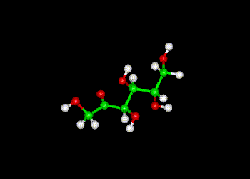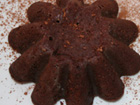 |
Fructose (or levulose) is a simple sugar (monosaccharide) found in many foods and is one of the three most important blood sugars along with glucose and galactose. Honey; tree fruits; berries; melons; and some root vegetables, such as beets, sweet potatoes, parsnips and onions, contain fructose, usually in combination with sucrose and glucose. Fructose is also derived from the digestion of sucrose, a disaccharide consisting of glucose and fructose that is broken down by glycoside hydrolase enzymes during digestion. Fructose is the sweetest naturally occurring sugar, estimated to be twice as sweet as sucrose.
Fructose is often recommended for, and consumed by, people with diabetes mellitus or hypoglycemia, because it has a very low Glycemic Index (GI) relative to cane sugar (sucrose). However, this benefit is tempered by concern that fructose may have an adverse effect on plasma lipid and uric acid levels, and the resulting higher blood levels of fructose can be damaging to proteins (see below). The low GI is due to the unique and lengthy metabolic pathway of fructose, which involves phosphorylation and a multi-step enzymatic process in the liver. See health effects and glycation for further information.
Structure formula of fructose

Fructose, or levulose, is a levorotatory monosaccharide and an isomer of glucose (C6H12O6). The chemical composition of fructose is (C6H12O6). Pure fructose has a sweet taste similar to cane sugar, but with a "fruity" aroma. Although fructose is a hexose (6 carbon sugar), it generally exists as a 5-member hemiketal ring (a furanose). This structure is responsible for the long metabolic pathway and high reactivity compared to glucose.
The first -OH points the opposite way from the second and third -OH.
Isomerism
D-Fructose has the same configuration at its penultimate carbon as D-glyceraldehyde. Fructose is sweeter than glucose due to its stereomerism structure.
 alpha-D-Fructose |
 beta-D-Fructose |
 alpha-L-Fructose |
 beta-L-Fructose |
Health effects
Fructose absoprtion occurs via the GLUT-5 [1] (fructose only) transporter, and the GLUT2 transporter, for which it competes with glucose and galactose. A deficiency of GLUT 5 may result in excess fructose carried into the lower intestine where it provides nutrients for the existing flora, which produce gas. It may also cause water retention in the intestine. These effects may lead to bloating, excessive flatulence, loose stools, and even diarrhea depending on the amounts eaten and other factors.
Fructose has been hypothesized to cause obesity [2], elevated LDL cholesterol and triglycerides, leading to metabolic syndrome. Unlike animal experiments, some human experiments have failed to show a correlation between fructose consumption and obesity. Short term tests, lack of dietary control, and lack of a non-fructose consuming control group are all confounding factors in human experiments. However, there are now a number of reports showing correlation of fructose consumption to obesity, especially central obesity which is generally regarded as the most dangerous type. (Wylie-Rosett, 2004)(Havel, 2005)(Bray, 2004) (Dennison, 1997)
Fructose also chelates minerals in the blood. This effect is especially important with micronutrients such as copper, chromium and zinc. Since these solutes are normally present in small quantities, chelation of small numbers of ions may lead to deficiency diseases, immune system impairment and even insulin resistance, a component of type II diabetes (Higdon).
"The medical profession thinks fructose is better for diabetics than sugar," says Meira Field, Ph.D., a research chemist at the USDA, in the Fall 2001 issue of the quarterly magazine of the Weston A. Price Foundation, "but every cell in the body can metabolize glucose. However, all fructose must be metabolized in the liver. The livers of the rats on the high fructose diet looked like the livers of alcoholics, plugged with fat and cirrhotic." This is not entirely true as certain other tissues do use fructose directly, notably the cells of the intestine, and sperm cells (for which fructose is the main energy source).
Fructose is a reducing sugar, as are all monosaccharides. The spontaneous addition of single sugar molecules to proteins, known as glycation, is a significant cause of damage in diabetics. Fructose appears to be as dangerous as glucose in this regard and so does not seem to be the answer for diabetes (McPherson et al, 1988) This may be an important contribution to senescence and many age-related chronic diseases (Levi & Werman 1998).Fructose is used as a substitute for sucrose (common sugar) because it is less expensive and has little effect on measured blood glucose levels. Often Fructose is consumed as high fructose corn syrup which is corn syrup (glucose) which has been enzymatically treated, by the enzyme glucose isomerase, to convert a portion of the glucose into fructose thus making it sweeter. This is done to such a degree to yield corn syrup with an equivalent sweetness as sucrose by weight. While most carbohydrates have around the same amount of calories, fructose is sweeter, so manufacturers may use less fructose to get the same sweetness. The free fructose present in fruits, their juice, and honey is responsible for the greater sweetness of these natural sugar sources.
References
- Buchs, AE; Sasson S, Joost HG, Cerasi E. (1998). "Characterization of GLUT5 domains responsible for fructose transport". Endocrinology 139: 827-31. PMID 12399260.
- Elliott, B; Keim NL, Stern JS, Teff K, Havel PJ (2002). "Fructose, weight gain, and the insulin resistance syndrome". Am J Clin Nutr 76: 911-22. PMID 12399260.
- Levi B, Werman MJ. Long-term fructose consumption accelerates glycation and several age-related variables in male rats. J Nutr 1998;128:1442-9. Fulltext. PMID 9732303.
- McPherson JD, Shilton BH, Walton DJ. Role of fructose in glycation and cross-linking of proteins. Biochemistry 1988;27:1901-7. PMID 3132203.
- Higdon, J., Linus Pauling Institute, Oregon State U. Chromium 2003
- Field, Meira. "Wise Traditions in Food, Farming and the Healing Arts", 2001 Fall,
Weston A. Price Foundation.
- Wylie-Rosett,Judith, et al, Carbohydrates and Increases in Obesity: Does the Type of Carbohydrate Make a Difference? Obesity Research 12:124S-129S (2004)[1]
- Havel, PJ, Dietary fructose: Implications for dysregulation of energy homeostasis and lipid/carbohydrate metabolism. Nutr Rev. 2005 May;63(5):133-57 [2]
- Bray, George A, Consumption of high-fructose corn syrup in beverages may play a role in the epidemic of obesity American Journal of Clinical Nutrition, Vol. 79, No. 4, 537-543, April 2004
- Dennison, Barbara Excess Fruit Juice Consumption by Preschool-aged Children Is Associated With Short Stature and Obesity, PEDIATRICS Vol. 99 No.1, January 1997, pp. 15-22
